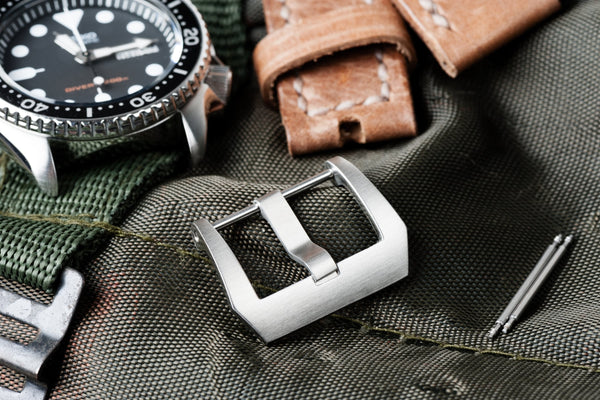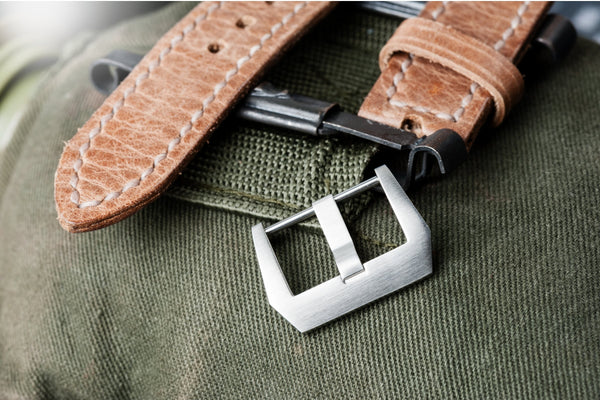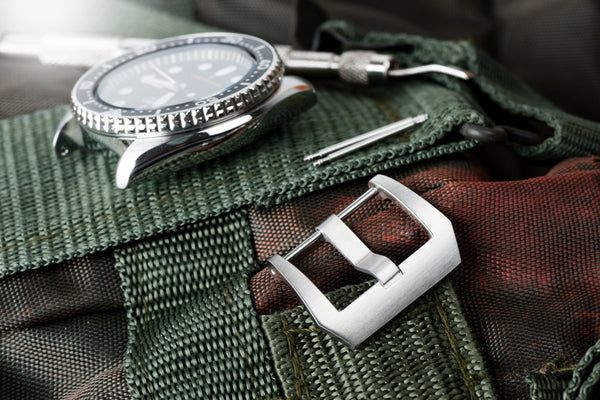NATO straps and Zulu straps are both distinctive watch band options for collectors, divers, soldiers, and even military personnel. Originating as British military watch straps designed for durability and additional security, they differ in several key aspects, including material thickness, hardware design, construction features, aesthetics, and ease of use.
These five key differences make each watch strap type uniquely suited for specific needs, whether you're swapping out a metal bracelet for a replacement watch strap or preparing for extreme conditions.
1. Material Thickness and Comfort
Zulu straps use thicker nylon materials, making them better suited for rugged use, while NATO straps offer a lighter and more comfortable experience.

NATO Strap: Straps of nylon such as in NATO style straps, are usually thinner and comprise a single piece of fabric, making for a more comfortable strap experience. The thinner material is versatile enough for a variety of settings, ranging from navy field watches to formal occasions.
Zulu Strap: Zulu-style straps feature thicker nylon and are often made from heavy-duty materials like robust nylon or even rubber. While not as comfortable on the wrist as NATO straps, they are more suitable for extreme activities and conditions.
Read more: Leather Watch Strap Conditioner | Top 10 Favourites
2. Hardware and Design
NATO watch straps feature slimmer metal hardware, while Zulu straps use chunkier, more robust hardware. The distinct style of metal elements in each band not only contributes to its overall aesthetic but also affects how the strap loops around your wrist for fit and comfort.
NATO Strap: The hardware in NATO straps often features rounded corners and rectangular keepers, while the slimmer metal hoops add a touch of sophistication to the strap design.
Zulu Strap: In contrast, Zulu watch straps come with robust metal hardware, including thicker buckles and rigid keepers. The metal hoops in Zulu straps are generally more substantial, emphasizing their rugged look.
3. Construction and Security
The NATO strap's extra loop and additional piece of fabric provide an extra layer of security, a feature born from its origins as a military strap. This additional layer makes it distinct from Zulu straps, which lack this safeguard and offer a simpler pass-through type construction.

NATO Strap: NATO straps have an extra loop and an additional piece of fabric that runs under the watch offer an extra layer of security. This bit of strap on the NATO acts as a failsafe if a spring bar breaks, ensuring the watch remains on your wrist. In many ways, this can be seen as a military requirement for additional security and robustness.
Zulu Strap: Zulu straps usually don't have this extra piece, making them a simpler pass-through strap type without the double loop for additional security. The lack of this feature could make them less ideal for those requiring an extra layer of protection.
Read more: What is the Best Leather for Watch Straps?
4. Aesthetic and Authentic Color
NATO straps offer a greater variety of colors and a sleeker look, while Zulu straps have a more utilitarian aesthetic. From the iconic green stripes to the finer details like the flap in the strap design, each adds a layer of character to the respective bands.
NATO Strap: These cloth watch straps often come in a variety of colors, including the iconic regimental stripe worn by soldiers and the infamous 007 James Bond. This variety makes them more versatile and suitable for formal occasions as well.
Zulu Strap: Zulu straps typically come in more utilitarian colors, matching the needs of military personnel and those requiring a strap for extreme conditions. The colors are often solid and less flashy, fitting the function-first ethos of these bands.
5. Ease of Use and Spring Bars
NATO straps offer the convenience of not having to remove the spring bars, a particularly useful feature if a broken spring bar occurs, while Zulu straps usually require their removal for installation or adjustment. The way the buckle loop is designed in each also contributes to how easily the strap can be manipulated.

NATO Strap: One advantage of NATO straps is the ease with which they can be changed without removing the spring bars, a handy feature if you're a diver in need of swapping straps before replacing an oxygen tank. The presence of the extra layer also acts as a failsafe against a broken spring bar, keeping your watch securely in place.
Zulu Strap: Generally, these straps require the removal of the spring bars for installation or removal, making them less convenient in time-sensitive situations. Their design usually doesn't include a failsafe against a broken spring bar, which can be a drawback depending on your use-case.
Read more: Are NATO Straps Comfortable?
Watch Strap Alternatives: Perlon & Metal Bracelets
While NATO and Zulu straps offer their unique features, they're not the only options. Perlon straps and croc straps provide alternative textures and aesthetics. Metal bracelets, often used for more formal occasions, feature plated brass or stainless steel construction. For those with specific preferences, a dedicated strap maker can craft something uniquely tailored to your taste.
Understanding these five key differences will guide your choice for a military watch strap, a versatile option suitable for a variety of colors and outfits, or for dive watches. Thinner nylon is favored by NATO, while Zulu straps use thicker, more robust material. Each has distinct advantages and disadvantages. The next time you're in the market for an additional strap or a replacement watch strap, keep these five key differences in mind to make the most informed choice for your needs.
View Band and Bezel's extensive collection of Canadian watch straps and watch strap replacements. All orders include fast free shipping, 1 year warranty, and your watch strap handmade with genuine quality materials.
